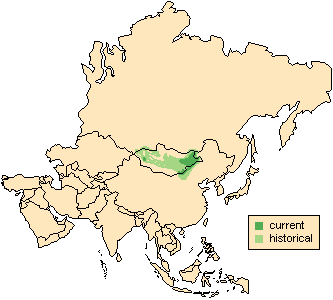![]() Return
to Artiodactyla
Return
to Artiodactyla
Classification
|
 Procapra
gutturosa
Procapra
gutturosa
Mongolian gazelle, Zeren
![]()
Taxonomy
General Characteristics
Body Length: 100-150 cm / 3.3-5 ft.
Shoulder Height: 54-84 cm / 1.8-2.8 ft.
Tail Length: 8-12 cm / 3.2-4.8 in.
Weight: 20-39 kg / 44-86 lb.The light brown or buff coat has pinkish tones in the summer, becoming longer (each hair being up to 5 cm / 2 inches long) and paler in winter. The darker uppercoat gradually fades into the white underparts, while the heart-shaped patch of white hair on the rump is sharply demarcated. The muzzle, chin, and jowls are white, while the bridge of the nose may be slightly darker than the body colour. During the breeding season, males develop a swollen throat, which resembles the condition of goiter, and are also said to have a bulbous muzzle. The eyes are small, but protrude from the head. Only males carry the dark gray, lyre-shaped horns, which curl backwards from the forehead and then run virtually parallel to the back. Slightly ridged along most of their length, the horns grow 25-40 cm / 10-16 inches long and diverge along their length, such that the tips are 6-10 times farther apart than the bases.
Ontogeny and Reproduction
Gestation Period: 185 days.
Young per Birth: 1-2, rarely 3
Weaning: After about 5 months.
Sexual Maturity: At 1.5-2 years.
Life span: Around 7 years.The mating season is based from November to January, with the resulting births occurring from May to July. Mating occurs within the herds, with harem behaviour not evidenced. The young lie hidden for their first few days of life, joining their mothers after 4-8 days.
Ecology and Behavior
In autumn and winter, these gazelles are active during the daylight hours, grazing in the morning and late afternoon. Beds are excavated in the lee of bushes where the animals are sheltered from the wind. Very speedy, zeren can gallop up to 65 kmph / 39 mph, and sustain this speed for 12-15 kilometers / 7-9 miles, leaping up to 2 meters / 6.6 feet into the air at intervals. They are good swimmers and can negotiate large rivers. Large scale migrations are undertaken by this species. Herds of 6,000-8,000 animals of both sexes gather in the spring, when the northerly movements begin, covering 200-300 kilometers / 120-180 miles in a single day. The summer pastures are reached in June, at which point the sexes segregate themselves, and the females prepare to give birth. Herds generally use several hundred square kilometers as a summer home range, regularly shifting their position in the search for food. Even outside of the migration, zeren will cover in excess of 20 kilometers / 12 miles per day. Normally silent, males may make a loud bellow during the rut.Family group: Single sex herds of 20-30 animals, during the winter they may be as large as 120.
Diet: Grasses and herbs.
Main Predators: Wolf.
Distribution
Grassy steppe and subdeserts of Mongolia, northern China, and southern Russia.

Range Map (Redrawn from Sokolov and Lushchekina, 1997)
Conservation Status
The Mongolian gazelle is a low risk, near threatened species (IUCN, 1996).
Remarks
The zeren is sometimes placed in the subgenus Prodorcas. Despite the 'goiter' which develops in adult males, care must be taken not to confuse this species with the goitered gazelle (Gazella subgutturosa). Zeren (or dzeren) is a Russian variation of the Mongolian name zeer. Pro (Latin) before; capra (Latin) a she-goat: suggesting that this genus is an ancestor of goats. Guttur (Latin) the throat; -osus (Latin) suffix meaning full of: the throat of adult males enlarges considerably during the breeding season.
Literature Cited
Heptner, V. G., A. A. Nasimovich, and A. G. Bannikov. 1989. Mammals of the Soviet Union. New York: E.J. Brill.Nowak, R. M. [editor]. 1991. Walker's Mammals of the World (Fifth Edition). Baltimore: The Johns Hopkins University Press.
Sokolov, V. E., and A. A. Lushchekina. 1997. Procapra gutturosa. Mammalian Species (571): 1-5.
Walther, F. R. 1990. Gazelles and related species. In Grzimek's Encyclopedia of Mammals. Edited by S. P. Parker. New York: McGraw-Hill. Volume 5, pp. 462-484.
Wilson, D. E., and D. M. Reeder [editors]. 1993. Mammal Species of the World (Second Edition). Washington: Smithsonian Institution Press. Available online at http://nmnhwww.si.edu/msw/
Return to Artiodactyla

![]()
© Brent Huffman, www.ultimateungulate.com |
|
|